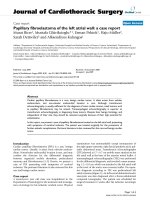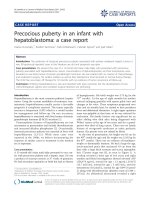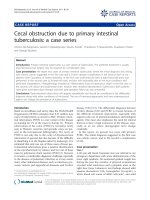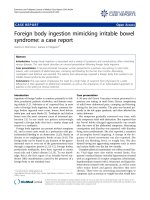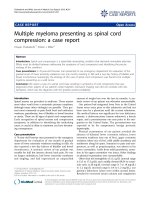Báo cáo y học: "Calcified multilocular thymic cyst associated with thymoma: a case report" pps
Bạn đang xem bản rút gọn của tài liệu. Xem và tải ngay bản đầy đủ của tài liệu tại đây (5.43 MB, 5 trang )
CAS E REP O R T Open Access
Calcified multilocular thymic cyst associated
with thymoma: a case report
Hafsa Elouazzani
*
, Fouad Zouaidia, Ahmed Jahid, Laila Laraqui, Zakiya Bernoussi and Najat Mahassini
Abstract
Introduction: There are fe w case reports of thymoma with a thymic cyst. Such an association renders it difficult
for any pathologist to differentiate from other neoplasms, such as a cystic thymoma.
Case presentation: A 50-year-old Berber woman from Morocco was admitted with a chronic cough of more than
10 years duration. Her medical history and physical exa mination were normal. Anterior chest radiography
demonstrated a calcified opacity in her right anterior mediastinum. A chest-computed tomogram revealed a round
cystic tumor, with significant calcification in her right anterior mediastinum. A surgical exploration was performed.
The tumor seemed to be a well-encapsulated and totally calcified lesion, arising from the right lobe of her thymus.
It was removed by partial resection of her thymus. Through histology, the calcified tumor exhibited some areas of
multilocular fibrous-wall cysts. These cysts were partially lined by small cuboidal cells with severe chronic
inflammation and an AB thymoma that arose from the wall of the cyst.
Conclusion: Greater attention should be given to multilocular thymic cysts, to exclude the possibility of neoplasm,
especially when the cyst wall is thickened.
Introduction
Multilocular thymic cysts are uncommon lesions of the
anterior mediastinum. On a regular histopathology
examination, they show significant inflammation and
fibrosis that can be associated with thymic neoplasm
such as th ymoma or thymic carcinoma. It is worth not-
ing that an association between thymoma and multilo-
cular thymic cysts has hardly ever been observed.
However, the possibility of other cystic thymic lesions,
essentially cystic degeneration of thymoma, must always
be considered [1].
We report an unusual AB thymoma case of a 50-year-
old woman in the wall of a calcified mu ltilocular thymic
cyst. Our study suggests that diffi culties related to the
diagnosis have been noted, a nd we advise that special
attention be given to every anterior mediastinal cystic
lesion.
Case presentation
A 50-year-old Moroccan Berber woman was admitted
with a chronic cough that has been going on for more
than 10 years, without history of smoking or neoplasm.
On admission, her physical examination and routine
biochemical tests were within normal limits. Chest
radiography showed a round calcified opacity on her
right anterior mediastinum. Computed tomography
(CT) of her thorax revealed a round cystic tumor, with
significant calcification, in her right anterior mediasti-
num (Figure 1). A surgical exploration revealed a well-
encapsulated and totally calcified lesion, arising from the
right lobe of her thymu s; it was totally removed by par-
tial resection of the thymus.
In a pathological examination of the surgical specimen,
the calcified tumor (15 × 8 × 6 cm) was well-encapsulated
and focally showed multilocular thick-wall cysts (Figure 2).
Histological examination revealed that the fibrous-wall
cysts were partially lined by small cuboidal cells, con-
taining smal l foci of lymphoid tissue with large areas of
cholesterol and calcification (Figure 3). In the wall of
the cyst we found neoplastic thymic elements composed
of spindled to oval cells with lymphocyte rich areas
(Figure 4). The pathological diagnosis was an AB
thymoma in the pre-existing thymic cyst.
* Correspondence:
Department of Pathology, Ibn Sina Hospital, Rabat, Morocco
Elouazzani et al. Journal of Medical Case Reports 2011, 5:225
/>JOURNAL OF MEDICAL
CASE REPORTS
© 2011 Elouazzani et al; licensee BioM ed Central Ltd. This is an Open Access article distributed under the terms of the Creat ive
Commons Attr ibution Lice nse ( , which permits unrestricted use, distribution, and
reprodu ction in any medium, provided the original work is properly cit ed.
Figure 1 CT of thorax. It shows a round cystic tumor, with significant calcification in the right anterior mediastinum.
Figure 2 Surgical specimen. The calcified tumor was well-encapsulated and showed focally a multilocular thick-wall cysts.
Elouazzani et al. Journal of Medical Case Reports 2011, 5:225
/>Page 2 of 5
Discussion
Benign thymic cysts are uncommon lesions that account
for approximat ely 3% of all anterior mediastinal masses.
Frequently, they are asymptomatic and the actual identi-
fication of the tumor is usually made after surgery and
histological examination [1].
Such cysts can either be congenital or acquired in ori-
gin. Congenital cysts are typically unilocular. They con-
tain clear fluid and have walls that are thin to the point
of translucen cy; they show no evi dence of inflammatio n
on careful histopathol ogical examination [2]. By con-
trast, acquired t hymic cysts result from an inflammatory
process. They are usually multilocular, hence the com-
monly used term “multilocular thymic cyst”. The cysts,
which contain turbid fluid or gelatinous material, have
thick and fibrous walls. Typically, they show evidence of
significant inflammation a nd fibrosis on histopathology
examination [3,4].
Multilocular thymic cysts may be associated with thy-
mic neoplasm such as thymoma or thymic carcinoma.
They may adhere to adjac ent structures and simulate an
invasive neoplasm at thoracotomy [5,6].
Multilocular thymic cyst associated with thymoma or
a malignant tumor is rare [6,7]. In such cases, the cystic
degeneration of a thymoma can be retained. It can
result in a gross pathologic appearance that simulates
multilocular thymic cyst [8] but histopathological exami-
nation reveals a complete absence of epithelial lining
within the cystic wall; this is an important feature of
cystic thymoma that differentiates it from thymic cyst
Figure 3 Photomicrograph. The fibrous-wall cysts (A), lined partially by small cuboidal cells (B), containing large areas of chole sterol (C),
calcification (D) and small foci of lymphoid tissue (E) (hematoxylin-eosin stain ×10).
Elouazzani et al. Journal of Medical Case Reports 2011, 5:225
/>Page 3 of 5
with thymoma. Indeed, in thymoma, the perivascular
spaces are the source of the cystic spaces [8,9].
In the case of thymic cyst with thymoma, the thy-
moma arises from the wall of a thymic cyst. This con-
sists of a large round mass and small flattened spindle-
shaped nodules [8,9]. Because f lat and spindle-shaped
mural nodules are difficult to observe when using CT
and magnetic resonance imaging, it is of vital impor-
tance that the histopathologic specimen be carefully
inspected to exclude co-existing neoplasia [5,6].
In our case, the calcified pattern hinders the possibility
to distinguish a multilocular cyst fro m cystic thymoma.
However, good sampling of the specimen allowed us to
see that the wall was lined with epithelial cells, and to
thereforeandmakeadiagnosis of multilocul ar thymic
cyst associated with thymoma.
For these lesions, to tal excision should be performed.
This remains the curative treatment of choice, and his-
tological examination is the only definitive means of
diagnosis [5,6]. Although thymoma with metas tasis or
recurrence have rarely been described, in our case the
partial resection of the thymus was performed for diag-
nosis and c urative treatment. The post- operative course
was uneventful and our patient has had no complica-
tions in their two year follow up.
Conclusion
In suspicious cases of multilocular thymic cysts, thor-
ough sampling of every “thymic cyst” must be carried
out. This is not only to establish an accurate diagnosis,
but also to exclude the possibility of neoplasm, espe-
cially when the cyst wall is thickened.
Consent
Written informed consent was obtained from the patient
for publicatio n of this case report and any accompany-
ing images. A copy of the written consent is available
for review by the Editor-in-Chief of this journal.
Acknowledgements
The authors would like to acknowledge the help of Yassine Ouadnouni MD
in confirming the diagnoses, and participating in the patient’s management.
Authors’ contributions
HE drafted the manuscript. FZ performed the case management, and
drafted the manuscript. AJ participated in confirming the diagnosis. LL
participated in the patient’s management. ZB and NB corrected the
manuscript. All authors read and approved the final manuscript.
Competing interests
The authors declare that they have no competing interests.
Received: 31 March 2010 Accepted: 21 June 2011
Published: 21 June 2011
References
1. De Caluwé D, Ahmed M, Puri P: Cervical thymic cysts. Pediatr Surg Int
2002, 18(5-6):477-479.
2. Choi YW, McAdams HP, Jeon SC, Hong EK, Kim YH, Im JG, Lee SR:
Idiopathic multilocular thymic cyst: CT features with clinical and
histopathologic correlation. AJR Am J Roentgenol 2001, 177(4):881-885.
3. Rahmati M, Corbi P, Gibelin H, Jayle C, Abdou M, Milinkevitch S, Menu P,
Kraimps JL: Management of thymic cysts. Ann Chir 2004, 129(1):14-19.
4. Hara M, Suzuki H, Ohba S, Satake M, Ogino H, Itoh M, Yamakawa Y,
Tateyama H: A case of thymic cyst associated with thymoma and
intracystic dissemination. Radiat Med 2000, 18(5):311-313.
Figure 4 Photomicrograph. An AB thymoma arising in the wall of the cyst (A) (hematoxylin-eosin stain ×10), composed of spindle to oval cells
with lymphocyte rich areas (B) (hematoxylin-eosin stain ×40).
Elouazzani et al. Journal of Medical Case Reports 2011, 5:225
/>Page 4 of 5
5. Yamashita S, Yamazaki H, Kato T, Yokota T, Matsumoto N, Matsukura S:
Thymic carcinoma which developed in a thymic cyst. Inter Med 1996,
35(3):215-218.
6. Leong AS, Brown JH: Malignant transformation in a thymic cyst. Am J
Surg Pathol 1984, 8(6):471-475.
7. Dyer NH: Cystic thymomas and thymic cysts, a review. Thorax 1967,
22(5):408-421.
8. Sugio K, Ondo K, Yamaguchi M, Yamazaki K, Kase S, Shoji F, Sugimachi K:
Thymoma arising in a thymic cyst. Ann thorac cardiovasc surg 2000,
6(5):329-331.
9. Makihara S, Umemori Y, Kotani K: Invasive thymoma with thymic cyst;
report of a case. Kyobu Geka 2007, 60(6):512-515.
doi:10.1186/1752-1947-5-225
Cite this article as: Elouazzani et al.: Calcified multilocular thymic cyst
associated with thymoma: a case report. Journal of Medical Case Reports
2011 5:225.
Submit your next manuscript to BioMed Central
and take full advantage of:
• Convenient online submission
• Thorough peer review
• No space constraints or color figure charges
• Immediate publication on acceptance
• Inclusion in PubMed, CAS, Scopus and Google Scholar
• Research which is freely available for redistribution
Submit your manuscript at
www.biomedcentral.com/submit
Elouazzani et al. Journal of Medical Case Reports 2011, 5:225
/>Page 5 of 5

